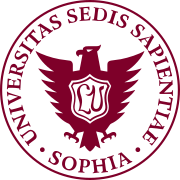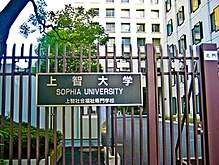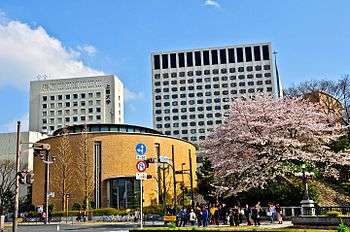Sophia University
|
上智大学 | |
 | |
|
Latin: Universitas Sedis Sapientiae (University of the Seat of Wisdom) | |
| Motto | Lux Veritatis |
|---|---|
Motto in English | Light of Truth |
| Type |
Catholic Private Research University |
| Established | 1913 |
Religious affiliation | Roman Catholic (Jesuit) |
| Chancellor | Rev. Fr. Tsutomu Sakuma, SJ[1] |
| President | Prof. Yoshiaki Terumichi, PhD[2] |
Academic staff |
1271 * 522 (Full-time) * 749 (Part-time) |
Administrative staff | 293 |
| Students | 11,986 |
| Undergraduates | 10,528 |
| Postgraduates | 1,208 |
Other students | 250 (Law) |
| Location |
Chiyoda, Tokyo, |
| Campus |
Urban: -Yotsuya main campus -Mejiro campus -Ichigaya campus -Shakujii campus |
| Alma Mater song | Sophia |
| Colors | Dark Red |
| Affiliations | AALAU, IAU, IFCU |
| Sports | 8 varsity teams |
| Mascot |
Eagle named Sophia-Kun |
| Website | www.sophia.ac.jp |
 | |

Sophia University (上智大学 Jōchi Daigaku) is a private Jesuit research university in Japan, with its main campus located near Yotsuya station, in an area of Tokyo's Chiyoda Ward. It is ranked as one of the top private universities in Japan, as well as the most prestigious. It takes its name from the Greek Sophia meaning "wisdom". The Japanese name, Jōchi Daigaku, literally means "University of Higher Wisdom".
It has an exchange program with many universities throughout the world, including Georgetown, Yale, Sogang University, University of Hong Kong, and University of Cologne. Prior to 1957 the university only admitted male students to degree programs, but the proportion of male to female students is now more or less equal. Sophia’s alumni are referred to as "Sophians"; they include the 79th Prime Minister of Japan, Morihiro Hosokawa, a number of politicians represented in the National Diet of Japan, and professors at various institutions.
History
Sophia University was founded by Jesuits in 1913. It opened with departments of German Literature, Philosophy and Commerce, headed by its founder Hermann Hoffmann (1864–1937) as its first official president.[3]
In 1932, a small group of Sophia University students refused to salute the war dead at Yasukuni Shrine in the presence of a Japanese military attache, saying it violated their religious beliefs. The military attache was withdrawn from Sophia as a result of this incident, damaging the university's reputation. The Archbishop of Tokyo intervened in the standoff by permitting Catholic students to salute the war dead, after which many Sophia students, as well as Hermann Hoffmann himself, participated in rites at Yasukuni. The Congregation for the Evangelization of Peoples later issued the Pluries Instanterque in 1936, which encouraged Catholics to attend Shinto shrines as a patriotic gesture; the Vatican re-issued this document after the war in 1951.[4]
Sophia University continued to grow by increasing the numbers of departments, faculty members and students, in addition to advancing its international focus by establishing an exchange program. Many of its students studied at Georgetown University in the United States as early as 1935. Sophia's junior college was established in 1973, followed by the opening of Sophia Community College in 1976. With the founding of the Faculty of Liberal Arts in 2006, Sophia University presently holds 27 departments in its eight faculties. Its current president is Yoshiaki Ishizawa. Toshiaki Koso serves as head of its board of directors. Since 2008, the Global Leadership Program was started for students from four Jesuit universities in East Asia: Ateneo de Manila University in the Philippines, Fu Jen Catholic University in Taiwan, Sogang University in South Korea, and Sophia University in Japan.[5] In 2016 the University reached out to the four Jesuit junior-senior high schools in Japan, joining them in the Sophia College Corporation to help them pass on the Jesuit charism to their lay faculty through workshops and other assistance. These schools are Sophia Fukuoka, Glory Academy, Hiroshima Academy, and Rokko School,[6]
Sophia's Research Institutes Division includes 11 research institutes with about 200 researchers.
- Institute for Christian Culture
- Institute of Global Concern (IGC)
- Institute of Medieval Thought
- Iberoamerican Institute
- Linguistic Institute for International Communication
- Institute of Comparative Culture
- European Institute
- Institute of Asian, African, and Middle Eastern Studies
- Institute of American and Canadian Studies
- Institute for Studies of the Global Environment
- Institute of Media, Culture and Journalism[7]
Campuses

Sophia's main campus, at Yotsuya, is urban, consisting of roughly 25 large, modern buildings in the center of Tokyo. The majority of Sophia's 10,000 undergraduate students spend nearly all their time here. The faculties of Humanities, Law, Foreign Studies, Economics, Liberal Arts, and Science and Technology have their home here, as do the main library, cafeteria, gymnasium, chapel, bookstore, and offices. In April 2006, the Faculty of Comparative Culture (FCC), which had been located at the smaller Ichigaya campus, moved to the main Yotsuya campus and changed its name to the Faculty of Liberal Arts.[8] Nearly all of Sophia's foreign exchange students study at FLA.
The Tokyo office of the Council on International Educational Exchange, the student exchange organization, which oversees roughly half of the international students, is also based on the main Yotsuya Campus. The Shakujii (Tokyo) campus houses the Faculty of Theology. The Hadano campus in Kanagawa Prefecture is home to the Sophia Junior College, as well as a number of seminar halls and athletics complexes.[9]


Academic Rankings
| Toyo Keizai National[10] | General | 41 |
|---|---|---|
| WE National[11] | Employment | 8 |
| NBP Greater Tokyo[12][13] | Reputation | 4 |
| Shimano National[14] | Selectivity | SA |
| Social Sciences & Humanities | ||
|---|---|---|
| LAW | ||
| BE Success National[15] | Qualification | 17 |
| BE Pass rate National[16] | Qualification | 29 |
There are several rankings below related to Sophia University.
Alumni rankings
Alumni of Sophia have good graduate prospects in Japanese industries. According to the Weekly Economist's 2010 rankings and the PRESIDENT's article on 2006/10/16, graduates from Sophia have the 8th best employment rate in 400 major companies, and the average graduate salary is the 6th best in Japan.[17][18]
Popularity and selectivity
Admission to Sophia is the most selective and competitive in Japan and considered the top private university along with Keio University and Waseda University. Typical acceptance rate is 5%. [19] Its entrance difficulty is considered one of the top with Waseda and Keio among 730 private universities.[20][21][22]
Notable faculty
- Gregory Clark, former professor of economics; currently a Japan Times contributor
- Kuniko Inoguchi, former professor of law, and Permanent Representative of Japan to the Conference on Disarmament in Geneva
- Father Peter Milward, SJ, emeritus professor of English Literature
- Jun-ichi Nishizawa, electronic engineer, inventor and specially-appointed professor;
- Sadako Ogata, former professor of political science, and former United Nations High Commissioner for Refugees; currently serving as President of the Japan International Cooperation Agency
Notable alumni
Government, politics, and society
- Agnes Chan, singer and ambassador of the Japan Committee for UNICEF
- Kōichirō Genba, DPJ member of the House of Representatives and former Minister for Foreign Affairs
- Sumihiro Kuyama, former Chairman, Joint Inspection Unit, United Nations
- Yukari Sato, economist and LDP member of the House of Representatives
- Shoichi Kondo, DPJ member of the House of Representatives and former Senior Vice-Minister of the Environment
- Noboharu Yonenaga, politician
- Kuniko Inoguchi, political scientist and politician, member of LDP
- Seiko Noda, politician, member of LDP
- Takuya Hirai, politician, member of LDP
- Seiichirō Dōkyū, politician, member of DPJ
- Yoshio Maki, politician
- Li Linsi, Chinese diplomat, educator, diplomatic consultant to Chiang Kai-shek
- Toshitsugu Saito, politician, 65th and 66th Minister of Defense
- Morihiro Hosokawa, 79th Prime Minister of Japan
- Mukhriz Mahathir, 11th Menteri Besar of Kedah, Malaysia
- Rizal Ramli, 3rd Coordinating Minister for Maritime Affairs of Indonesia
Academia
- Ruben Habito, associate professor at Southern Methodist University
- Yuya Kiuchi, sport and pop culture scholar at Michigan State University
- Kyouichi Tachikawa, historian
- Takayuki Tatsumi, American literature scholar at Keio University
- Dominique Turpin, Dean & President of IMD, Switzerland
- Shōichi Watanabe, English scholar
Business
- Peer Schneider, Co-founder and SVP/Publisher at IGN Entertainment
- Shuzo Shiota, CEO and president of Polygon Pictures
- Johnny Kitagawa, founder and CEO of Johnny & Associates
- Shawn Layden, President & CEO of Sony Interactive Entertainment America
Media & literature
- Yoshitaka Asama, screenwriter and film director
- Vernon Grant, first American cartoonist to introduce manga concepts to English-language readers
- Kōichi Mashimo, anime director, founder of studio Bee Train
- Maureen Wartski, author, including A Boat to Nowhere and Yuri's Brush with Magic
- Robert Whiting, author on Japanese culture, including The Chrysanthemum and the Bat and You Gotta Have Wa about Japanese baseball
- Yuriko Nishiyama, manga writer, including Harlem Beat
- Beni Arashiro, singer
- Boyé Lafayette De Mente, author on Japanese culture ('54)
- Jake Adelstein, journalist, consultant, and author of Tokyo Vice
Others
- Kurara Chibana, Miss Japan 2006 and 1st Runner-up at Miss Universe 2006
- Tina Chow, model and jewellery designer[23]
- Bruce Frantzis, Taoist Master, USA
- Yū Hayami, actress, singer
- Sumire Uesaka, anime voice actress
- Carrie Ann Inaba, American dancer, choreographer, actress, and singer
- Hisashi Inoue, author
- Maiko Itai, Miss Universe Japan 2010 winner
- Crystal Kay, singer
- Stephen Kim Sou-hwan, Korean Roman Catholic cardinal and Archbishop of Seoul
- Peter Shirayanagi, Japanese Roman Catholic cardinal and Archbishop of Tokyo
- Saori Kumi, author
- Alan Merrill, a 1960s Group Sounds pioneer gaijin tarento and later composer of the classic song "I Love Rock N Roll"
- Osamu Mizutani, high school teacher, famous for his book "Yomawari Sensei" and his efforts to redress delinquents
- Father Adolfo Nicolás, S.J., Superior General of the Society of Jesus
- Hikaru Nishida, actress, Japanese drama
- Judy Ongg, singer/actor
- Zomahoun Idossou Rufin, a gaijin tarento, philanthropist and diplomat who has been Benin's Ambassador to Japan and the Philippines
- Emyli, singer
- George Takei, Japanese-American actor most famous for his role as Star Trek's Mr. Sulu
- Tadashi Yamamoto, Founder of the Japan Center for International Exchange and the Shimoda Conference
- Michelle van Eimeren, Miss Universe Australia 1994
References
- ↑ https://www.sophia.ac.jp/eng/news/2018/0402news.html
- ↑ https://www.sophia.ac.jp/eng/news/2016/1117001.html
- ↑ "Hoffman".
- ↑ Breen, John (1 March 2010). "Popes, Bishops and War Criminals: reflections on Catholics and Yasukuni in post-war Japan". The Asia-Pacific Journal: Japan Focus. Retrieved 15 January 2014.
- ↑ Profile, hompi.sogang.ac.kr; accessed 22 September 2014.
- ↑ 日本管区. "The Society of Jesus - Japan Province イエズス会日本管区". www.jesuits-japan.org (in Array). Retrieved 2017-08-16.
- ↑ "Research Institutes Division". Sophia University. Retrieved 4 May 2018.
- ↑ "FLA". Retrieved October 13, 2015.
- ↑ "Hadano".
- ↑ "Truly Strong Universities" (in Japanese). Toyo Keizai. 2010. Retrieved April 29, 2011.
- ↑ "Employment rate in 400 major companies rankings" (in Japanese). Weekly Economist. 2011. Retrieved April 29, 2011.
- ↑ "Nikkei BP Brand rankings of Japanese universities" (in Japanese). Nikkei Business Publications. 2010. Retrieved April 29, 2011.
- ↑ "Nikkei BP Brand rankings of Japanese universities" (in Japanese). Nikkei Business Publications. 2009. Retrieved April 29, 2011.
- ↑ "GBUDU University Rankings" (in Japanese). YELL books. 2009. Retrieved April 29, 2011.
- ↑ "Bar Exam Successful Applicants rankings" (in Japanese). Shikaku Seek. 2010. Retrieved May 11, 2011.
- ↑ "Bar Exam Pass rate rankings" (in Japanese). Shikaku Seek. 2010. Retrieved May 11, 2011.
- ↑ "Employment rate in 400 major companies rankings" (in Japanese). Weekly Economist. 2011. Retrieved April 29, 2011.
- ↑ http://hensachi-ranking.seesaa.net/article/26733115.html#more
- ↑ http://www.sophia.ac.jp/jpn/admissions/gakubu_ad/gakubu_news/110117/2011ippan_syutuganjyokyo
- ↑ National and Public universities apply different kind of exams. so it's only comparable between universities in a same category.
- ↑ e.g., Yoyogi seminar published Hensachi (the indication showing the entrance difficulties by prep schools) rankings http://www.yozemi.ac.jp/rank/gakubu/index.html
- ↑ Japanese journalist Kiyoshi Shimano ranks its entrance difficulty as SA (most selective/out of 11 scales) in Japan. "危ない大学・消える大学 2012年版" (in Japanese). YELL books. 2011.
- ↑ Lambert, Bruce (January 26, 1992). "Bettina L. Chow, Model and Designer, Dies at 41". nytimes.com.
External links
- Sophia University Homepage (日本語 / Japanese)
- Sophia University Homepage (English / 英語)
- Sophia University Faculty of Liberal Arts (FLA) Homepage (English only)
Coordinates: 35°41′03″N 139°43′55″E / 35.68417°N 139.73194°E